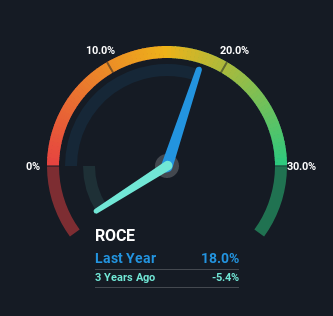Returns On Capital Are Showing Encouraging Signs At Harrisons Malayalam (NSE:HARRMALAYA)

If you're not sure where to start when looking for the next multi-bagger, there are a few key trends you should keep an eye out for. Typically, we'll want to notice a trend of growing return on capital employed (ROCE) and alongside that, an expanding base of capital employed. This shows us that it's a compounding machine, able to continually reinvest its earnings back into the business and generate higher returns. So on that note, Harrisons Malayalam (NSE:HARRMALAYA) looks quite promising in regards to its trends of return on capital.
What is Return On Capital Employed (ROCE)?
Just to clarify if you're unsure, ROCE is a metric for evaluating how much pre-tax income (in percentage terms) a company earns on the capital invested in its business. Analysts use this formula to calculate it for Harrisons Malayalam:
Return on Capital Employed = Earnings Before Interest and Tax (EBIT) ÷ (Total Assets - Current Liabilities)
0.18 = ₹395m ÷ (₹4.2b - ₹2.1b) (Based on the trailing twelve months to December 2021).
Thus, Harrisons Malayalam has an ROCE of 18%. In absolute terms, that's a satisfactory return, but compared to the Food industry average of 13% it's much better.
Check out our latest analysis for Harrisons Malayalam

While the past is not representative of the future, it can be helpful to know how a company has performed historically, which is why we have this chart above. If you'd like to look at how Harrisons Malayalam has performed in the past in other metrics, you can view this free graph of past earnings, revenue and cash flow.
What Can We Tell From Harrisons Malayalam's ROCE Trend?
Shareholders will be relieved that Harrisons Malayalam has broken into profitability. While the business was unprofitable in the past, it's now turned things around and is earning 18% on its capital. While returns have increased, the amount of capital employed by Harrisons Malayalam has remained flat over the period. With no noticeable increase in capital employed, it's worth knowing what the company plans on doing going forward in regards to reinvesting and growing the business. Because in the end, a business can only get so efficient.
On a separate but related note, it's important to know that Harrisons Malayalam has a current liabilities to total assets ratio of 48%, which we'd consider pretty high. This effectively means that suppliers (or short-term creditors) are funding a large portion of the business, so just be aware that this can introduce some elements of risk. Ideally we'd like to see this reduce as that would mean fewer obligations bearing risks.
What We Can Learn From Harrisons Malayalam's ROCE
As discussed above, Harrisons Malayalam appears to be getting more proficient at generating returns since capital employed has remained flat but earnings (before interest and tax) are up. And with a respectable 84% awarded to those who held the stock over the last five years, you could argue that these developments are starting to get the attention they deserve. With that being said, we still think the promising fundamentals mean the company deserves some further due diligence.
On a separate note, we've found 2 warning signs for Harrisons Malayalam you'll probably want to know about.
While Harrisons Malayalam may not currently earn the highest returns, we've compiled a list of companies that currently earn more than 25% return on equity. Check out this free list here.
Valuation is complex, but we're here to simplify it.
Discover if Harrisons Malayalam might be undervalued or overvalued with our detailed analysis, featuring fair value estimates, potential risks, dividends, insider trades, and its financial condition.
Access Free AnalysisHave feedback on this article? Concerned about the content? Get in touch with us directly. Alternatively, email editorial-team (at) simplywallst.com.
This article by Simply Wall St is general in nature. We provide commentary based on historical data and analyst forecasts only using an unbiased methodology and our articles are not intended to be financial advice. It does not constitute a recommendation to buy or sell any stock, and does not take account of your objectives, or your financial situation. We aim to bring you long-term focused analysis driven by fundamental data. Note that our analysis may not factor in the latest price-sensitive company announcements or qualitative material. Simply Wall St has no position in any stocks mentioned.
About NSEI:HARRMALAYA
Harrisons Malayalam
Harrisons Malayalam Limited plants and sells tea and rubber in India, Europe, and internationally.
Moderate and fair value.
Market Insights
Community Narratives




